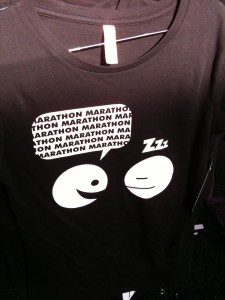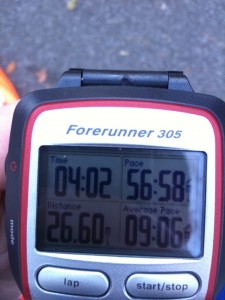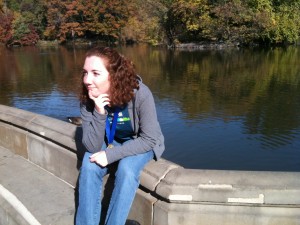I find myself in the position of wanting to write many blog posts but not knowing where to start. But for now, I’ll bore you with some post-New York City Marathon thoughts. (This is Sunday, when people don’t seem to read as many blogs, anyway.)

First of all, I neglected to post race stats in my report.
- 708 of 3,068 in my division (females, ages 30-34). Top 23 percent.
- 3702 of 16,928 female finishers. Top 21.9 percent.
- 16194 of all 46,795 finishers. Top 34.6 percent.
- Fastest of the three Laylas in the race (second place finished four minutes behind me).
I honestly believe that, had I either not fallen two weeks before the marathon, OR if the crowding hadn’t been so intense, I would have broken 4 hours in the marathon. I’m not upset about this, because those are both significant factors. Despite everything, I ran a pretty solid race. I ran the first half in 2:01:51 and the second half in 2:00:29. This is the best way to run a marathon — try to run an even effort throughout, and if you have anything left, throw it all out there at the end. Otherwise, you’ll start out fast and burn out long before the end of the race.
The crowding was to be expected, since 47,000 people were running the marathon. However, it made me run 26.6 miles instead of 26.2 miles, because I was dodging around so many people.

There are three different start times to help ease the crowding, and runners are assigned to starts based on their own predicted finishing time. This is where some people ruin it for others, because they list unrealistic finish times in order to get closer to the front. They start out way too fast, slow down once the adrenaline has burned off, and then create a huge bottleneck for everyone else trying to run an even effort at a realistic pace. I got into a debate with someone on a message board about this: He runs marathons in about 4:15 to 4:45, but for New York he listed his expected finish time as 3:29. His half-marathon PR (personal record) is around 1:47; based on this time, there is almost no way he would finish in 3:29 — he’d have to run 26.2 miles at a significantly faster average pace than the fastest he’s ever run half that distance. So, he started near the front at NYCM, ran the half in 1:58, then ran the second half in 2:20. He even admitted that he started out way too fast (and yet, to actually run a 3:29, he would have had to reach the halfway point at no slower than 1:45). He should NOT be lying on registration forms for the New York City Marathon. Many people do this, though. I hate this, because it gives runners a bad name.
Even with the crowding, I believe I could have run 3:59 if I hadn’t fallen two weeks earlier. The day after that fall, I went out and ran 20 miles. At times it was very hard, but I finished that run faster than expected (9:20 pace, though this is a bit misleading because I stopped several times for such things as water, etc). I had no muscle soreness afterward — though maybe I just didn’t notice it because my knee wounds hurt so badly. I’d planned to get out on my bike at least twice during the next two weeks, but one hand had also been wounded and couldn’t hold the handlebars. Almost all stretching came to a stop, too, because every knee bend was excruciating. It was so hard to even get down on the floor, because I only had one hand to lift myself back up — and I couldn’t roll over on my knees to get up that way.
And then I went off to New York City, where everyone walks. It was too cold for bare knees, so I put on bandaids and pants. Every single step was torture, because those raw wounds rubbed against the bandages. I walked stiff-legged through the city, which is not the best thing to do in the days leading up to a 26.2-mile run. While there, I also completely neglected my daily vitamins. I’ve done pretty extensive testing and research over the past year, and have concluded that magnesium and stretching will keep almost all of my calf muscle cramps at bay. For the five days leading up to the marathon, I didn’t take magnesium, and I did almost no stretching in the two weeks prior to the marathon. Oops.
Regarding recovery, my quads (thigh muscles) weren’t too bad, considering we’d gone up and down five bridges, and such hills usually cause muscle soreness later. Instead, I had a new kind of pain: In the days after the marathon, my feet were in agony. The arches hurt. One arch wasn’t as bad, but the outside of the foot hurt because I’d unintentionally started walking on it in an effort to take the pressure off the sore spots.
Two weeks later, I still can’t wear the shoes in which I ran the marathon. I’m currently using two identical pairs, both have plenty of life left in them, and both of them make my feet scream as soon as I’ve run one-tenth of a mile. Twice, I’ve gone out for a run, only to turn around and change into other shoes. Then I go back out, and things are OK. I’m frustrated, because I love those shoes. They’re the best ones I’ve ever worn. I suspect the problem may be that I went up half a size after the Alaska marathon in June, where I got horrible blisters under my toenails and ultimately lost four toenails. My toes were completely unscathed after NYCM (a first!), but maybe the shoe arches don’t fit me properly. So, yesterday I went to the shoe store, plunked down a stupid amount of money on a different brand of shoes, and I’m going to try them out. It’s frustrating, to say the least.
As I write this, I have six weeks to another marathon. I want so badly to see a 3 at the front of that finish time. I am SO CLOSE, and I know I can do it. I just need to stay healthy, avoid injuries and hope the feet like the new shoes. I should also lose some weight. Oh, and I hope the back strain goes away soon. (Yes, that’s right, I managed to strain my back. If it’s not one thing, it’s another!)
Another interesting stat from the NYCM web site: There were 666 female California finishers — how’s that for a wacky number? (1,489 total runners from California)
I usually don’t want to run the same race again, because there are so many interesting races and I know I’ll only be able to run so many of them in this lifetime. However, I’d love to run New York again. I would happily get on the subway before dawn, wait for hours before the marathon start and battle through the crowds. I loved the spectators, the race support, the atmosphere, the energy. I loved running through New York City. I would buy cross-country plane tickets and pay the outrageous entry fee just to do it all over again.

And the best spectator sign of the day: “Worst Parade Ever!” I actually laughed when I saw that in Brooklyn.
i love reading your blog layla, not just for 1) what it is you write about but HOW you write about it. Your reflectiveness and insight remind me a lot of myself and I love getting to read your thoughts! Not in a creepy way though…
Lol….I am totally going to start comparing myself to everyone else in my races with my name & include it as a stat in my race reports. WINNER OF THE LAYLAS!!!
Great thoughts on a great race. I agree with the best sign: “worst parade ever” – I had almost forgotten about it until I read your blog!